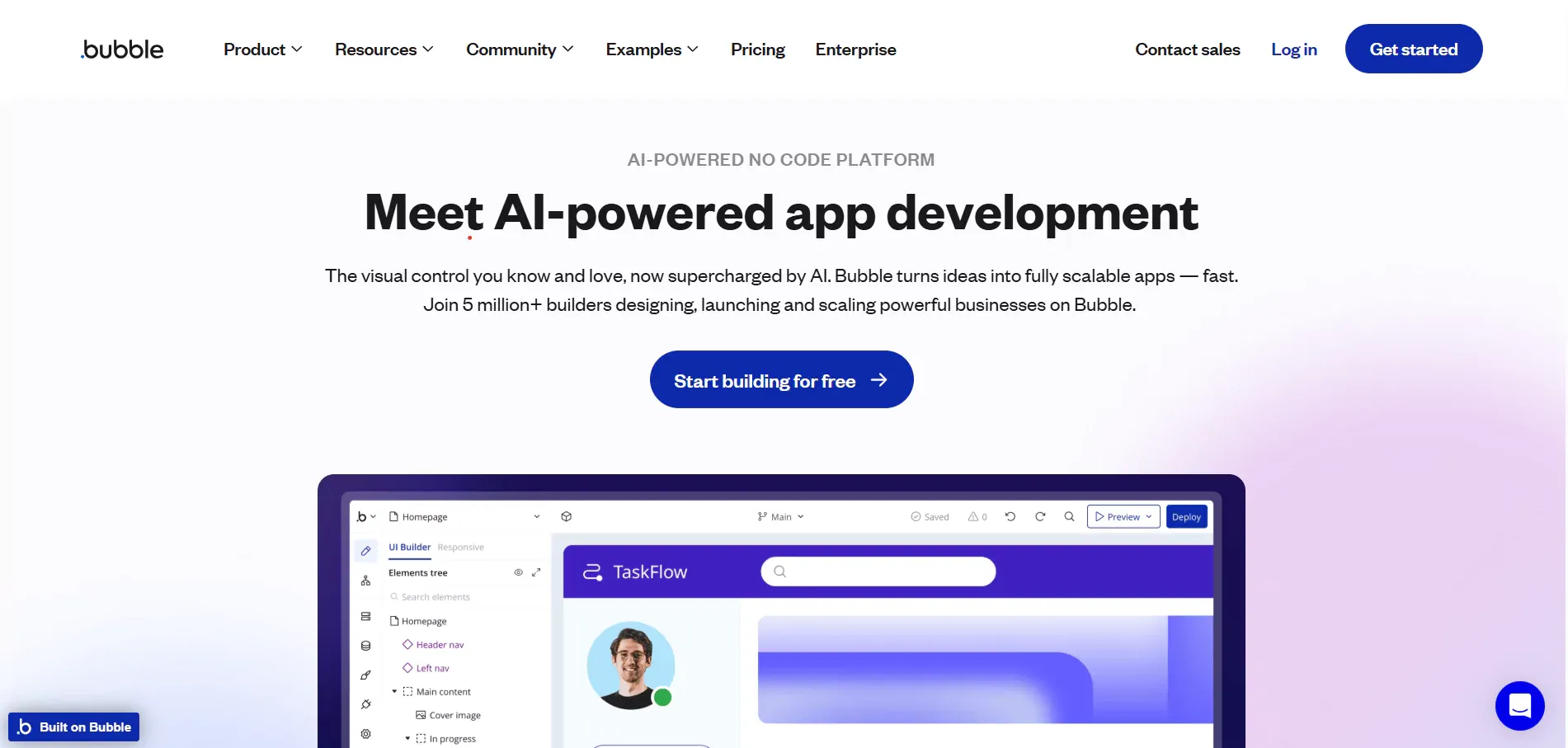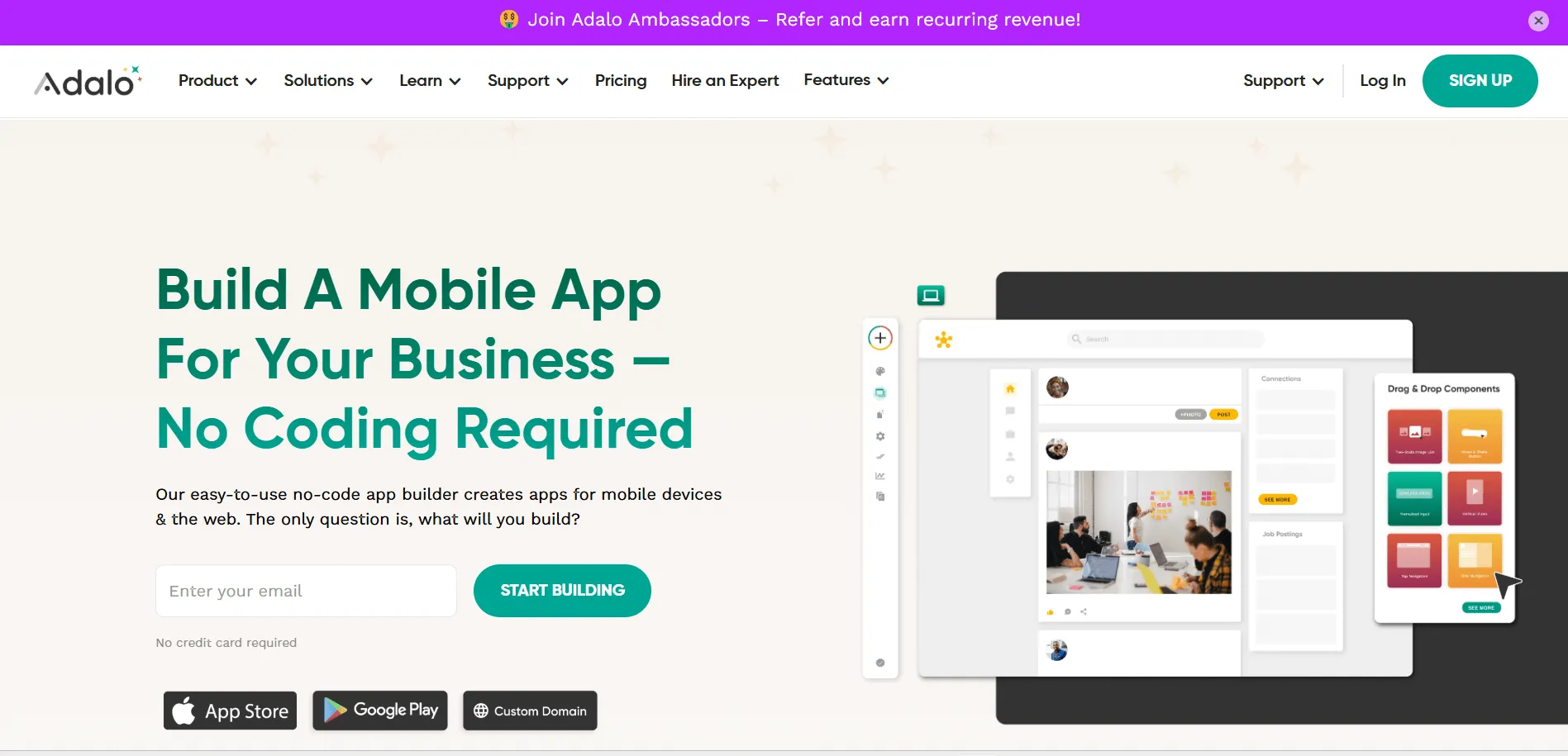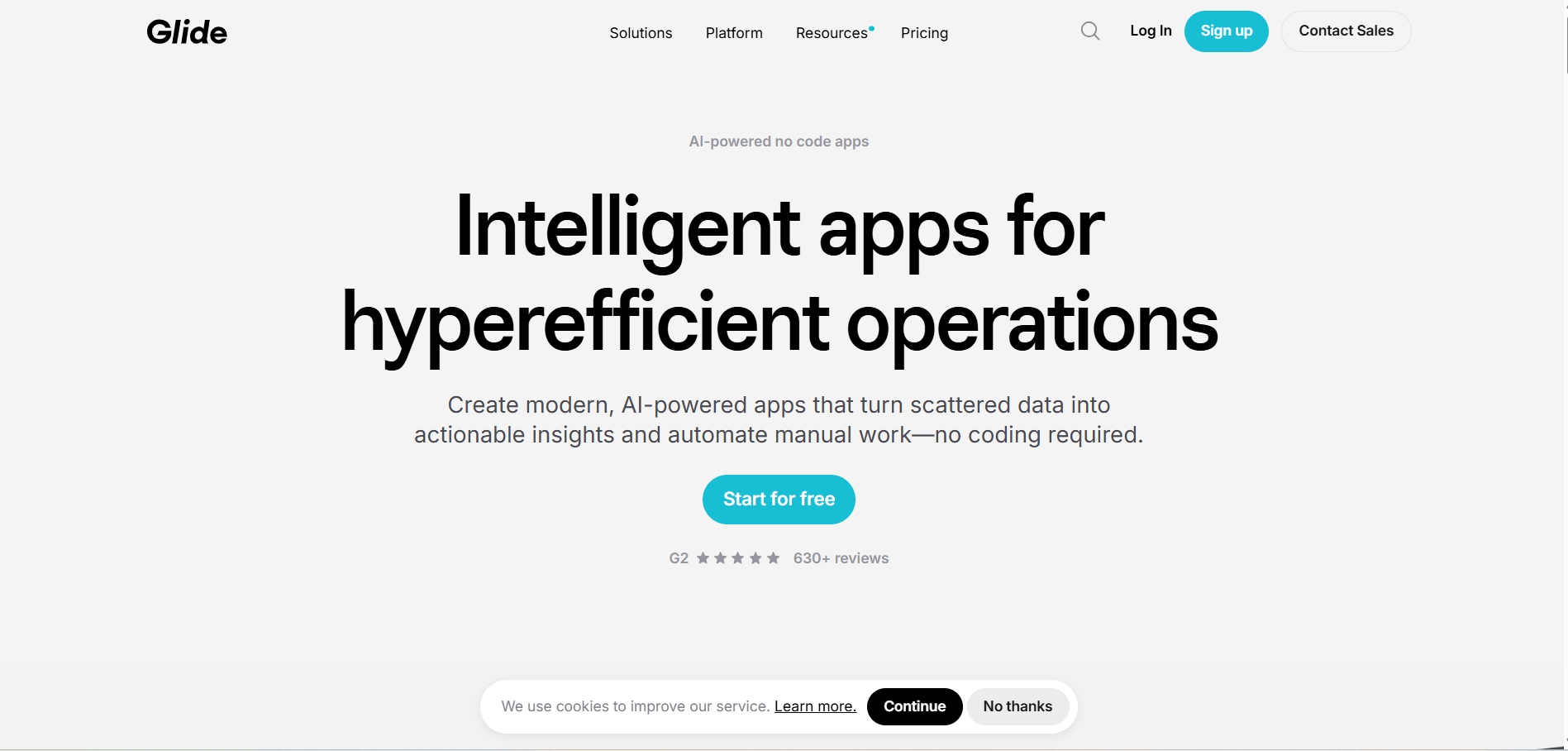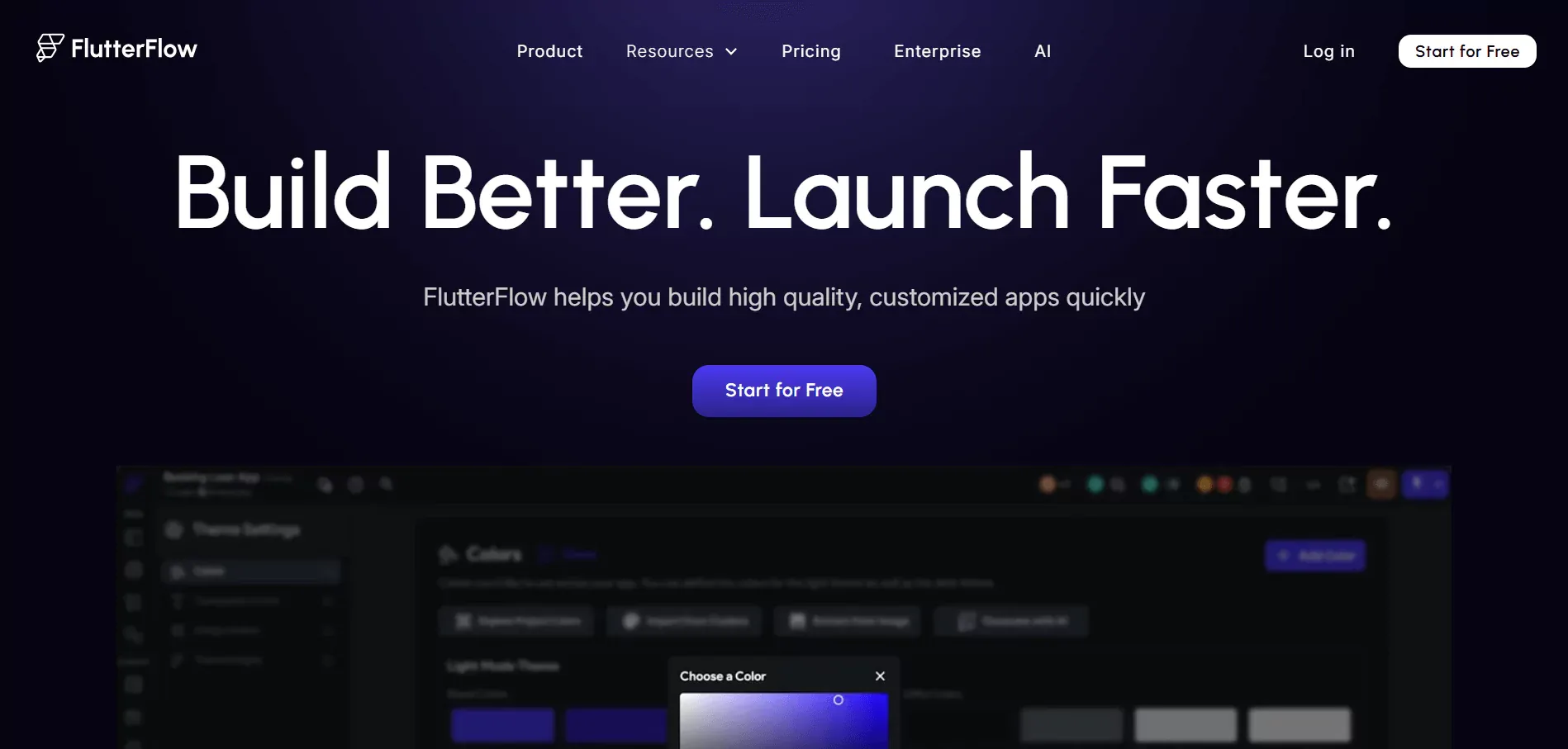
Design Converter
- Technologies
Flutter
React
Shopify
Android
iOS
Flutter
React
Shopify
Android
iOS
- Resource
University
Documentation
Templates
UI Accuracy
Discord
University
Documentation
Templates
UI Accuracy
Discord
- Pricing

Design Converter
Education
Last updated on Apr 10, 2025
•13 mins read
Last updated on Apr 10, 2025
•13 mins read








Bubble io revolutionized no-code web development with its drag-and-drop builder and built-in backend logic. But like any platform, it’s not without its downsides. Some users find it limiting in performance, others seek better native mobile support or more customization.
The Bubble community is a valuable resource for no-code app development. It offers a wealth of pre-built apps and templates that can accelerate the building process and enhance project customization and functionality.
As the no-code ecosystem evolves rapidly, many platforms now offer powerful features that compete—or even outperform—Bubble in specific areas. Let’s explore the best alternatives in 2025.
Bubble io is a popular no-code platform that enables users to build web and mobile applications without writing traditional code. It provides a visual programming language that allows users to create complex software for any use case much faster and cheaper.

Bubble io is a cost-effective solution for building custom, web, and mobile apps, with a pricing model consisting of four tiers. The free plan allows users to explore basic features, while the paid plans offer more advanced features and support for app deployment. This makes Bubble io an attractive option for startups and businesses looking to develop web and mobile apps without extensive coding knowledge.
Before diving into alternatives, it’s important to understand why users consider switching from Bubble io:
When selecting a Bubble io alternative, consider:
Additionally, evaluate each bubble alternative based on its unique advantages, features, and pricing models to find the best fit for your business needs.
Bubble io is a no-code platform that enables users to build web and mobile apps without writing code. It is a popular choice for creating custom apps, web applications, and mobile apps due to its user-friendly visual programming language. This language mimics traditional programming, making it accessible for technical and non-technical users.
Bubble offers a cost-effective solution with a tiered pricing model. The free plan allows users to explore basic features, while the paid plans provide access to more advanced features and support for app deployment. This makes Bubble an attractive option for startups and businesses looking to develop web and mobile apps without the need for extensive coding knowledge. Additionally, there are several no code bubble alternatives available that offer different features and capabilities.
While Bubble io is a powerful no-code platform, it does have some technical limitations. For instance, it may not be the best fit for highly complex or customized apps that require extensive business logic and coding expertise.
Bubble’s scalability and performance capabilities might also fall short for very large or high-traffic applications. Despite these limitations, Bubble is continually evolving, focusing on enhancing its flexibility and scalability. This ongoing development aims to provide a robust solution for building custom, web, and mobile apps, making it a versatile choice for many projects.
Bubble’s pricing model consists of four tiers, starting with a free plan that allows users to explore basic features. The paid plans, which start at $29/$32 per month, offer more advanced features and support for app deployment. The cost of building a Bubble app can vary significantly based on the project's complexity and whether you hire a freelance developer or an agency.
Typically, the development cost for most Bubble apps ranges from $20,000 to $200,000, depending on the feature set’s complexity. To help users estimate their expenses, Bubble provides a cost calculator, making it easier to budget for app development. Hiring a Bubble developer can expedite the app-building process, especially for those looking to launch quickly.
Bubble takes security and compliance seriously, offering robust security measures to ensure a secure and reliable platform for building web and mobile apps. The platform includes enterprise-grade security features and complies with industry standards such as GDPR and HIPAA. Additionally, Bubble provides tools and resources to help users maintain the security and compliance of their apps, including data encryption and access controls. This focus on security makes Bubble a trustworthy choice for businesses handling sensitive data.
Bubble offers a range of learning and support resources to help users get started with the platform and build their apps. These resources include comprehensive tutorials, detailed documentation, and an active community forum where users can ask questions and receive help from other users and Bubble experts.
Additionally, Bubble provides various support plans, including email support and priority support, ensuring that users can get the assistance they need when they need it. This extensive support network makes it easier for users to navigate the platform and successfully develop their web and mobile apps. The Bubble community is also a valuable resource for no-code app development, offering pre-built apps and templates that can enhance project customization and functionality.
There are several key features to consider when looking for a Bubble alternative. These include:
What is it? Appsmith is a low-code platform that offers a range of features, including drag-and-drop functionality, pre-built templates, and integration capabilities. It is ideal for building internal tools and custom internal tools with ease.

Best for: Businesses and teams looking to streamline internal processes with custom internal tools.
Why it’s a great Bubble.io alternative: Appsmith provides a user-friendly interface and advanced features that simplify the creation of internal tools, making it a strong choice for businesses seeking a no-code solution with powerful integration and automation capabilities.
What is it? Webflow is a visual web design tool that also handles hosting, CMS, and interactions. Its visual interface allows users to easily add and configure various application components, simplifying the app development process.

Best for: Web designers and startups looking for responsive websites with animations.
Downside: Not ideal for logic-heavy or complex web apps.
What is it? Adalo is a no-code platform specializing in building native mobile applications with drag-and-drop ease.

Best for: MVPs and startups building simple iOS/Android apps.
Why better than Bubble for mobile apps? Adalo provides native builds for mobile, which Bubble lacks. Adalo apps can be published directly to official app stores, offering greater accessibility and platform flexibility.
What is it? OutSystems is a powerful low-code platform used by enterprises to build scalable business apps.

Best for: Large teams and enterprise-grade apps.
Downside: Has a steeper pricing model and is enterprise-focused.
What is it? Glide lets you build apps from Google Sheets or Airtable with minimal effort.
Best for: Internal tools, internal apps, admin dashboards, and database-driven apps.

Downside: Less control over frontend design.
What is it? A professional no-code platform acquired by SAP, Appgyver supports complex mobile app logic.

Best for: Developers seeking free, customizable mobile app building and robust workflow automation capabilities.
Upside: Completely free for indie developers!
What is it? FlutterFlow is a no-code/low-code builder that generates Flutter code for cross-platform apps.
Best for: Teams building visually rich mobile apps with Flutter, enabling users without technical skills to create and customize applications efficiently.

| Platform | Best For | Mobile Support | Code Export | Pricing |
|---|---|---|---|---|
| Appsmith | Internal tools | ❌ | ✅ Strong integration capabilities | Freemium |
| Webflow | Responsive websites | ❌ | ✅ Partial | Starts at $18/mo |
| Adalo | Simple mobile apps | ✅ Native | ❌ | Starts at $36/mo |
| OutSystems | Enterprise-grade apps | ✅ Native | ❌ | Enterprise pricing |
| Glide | Database-driven apps | ✅ (PWA) | ❌ | Freemium |
| Appgyver | Custom mobile logic apps | ✅ Native | ✅ | Free |
| FlutterFlow | Flutter-based mobile apps | ✅ Native | ✅ Full | Starts at $30/mo |
Here are the top 4 no-code platform alternatives to Bubble io:
A low-code platform that excels in creating internal tools and business processes. It offers drag-and-drop functionality, pre-built templates, and strong integration capabilities with third-party services.
A low-code platform designed for enterprise-grade applications. It provides drag-and-drop functionality, pre-built templates, and robust integration capabilities, making it suitable for building complex apps and custom web applications.
A no-code platform that empowers citizen developers to create web and mobile apps. It offers drag-and-drop functionality, pre-built templates, and integration capabilities, making it a versatile choice for various app development needs.
A no-code platform enabling users to quickly build web applications and internal tools. It offers drag-and-drop functionality, pre-built templates, and integration capabilities, making it a user-friendly option for non-technical users.
Choosing the best Bubble alternative depends on several factors, including the specific needs of your project, your level of technical expertise, and your budget. Here are some tips to help you choose the best Bubble alternative:
Consider Your Project Requirements: Consider the specific features and functionality you need for your project. Do you need integration capabilities? Do you need advanced features such as workflow automation? Make a list of your requirements to narrow down your options.
Evaluate the Platform’s Ease of Use: Consider how easy the platform is to use, especially if you are a non-technical user. Look for platforms with intuitive and user-friendly interfaces that simplify the app development process.
Consider the Platform’s Scalability: Consider the platform's scalability. Can it handle large amounts of data and traffic? Ensure that it can grow with your business needs.
Evaluate the Platform’s Security: Consider the security measures in place to protect sensitive data. Look for platforms that offer enterprise-grade security features and comply with industry standards.
Consider the Platform’s Pricing: Consider the platform's cost and whether it fits within your budget. Compare the pricing models of different platforms to find the best value for your needs.
Considering these factors, you can choose the best Bubble alternative that meets your project requirements and helps you achieve your app development goals.
Bubble remains a top choice for many, but it’s no longer the only player in the no-code game. Several platforms may suit you better depending on your project’s complexity, need for control, and performance goals.
If you’re looking for a hybrid between no-code ease and dev-level control, platforms offering real code, scalable architecture, and mobile support stand out as future-proof alternatives in 2025. Certain plans also include cloud deployment support, offering flexibility and compliance in your app development process.
Tired of manually designing screens, coding on weekends, and technical debt? Let DhiWise handle it for you!
You can build an e-commerce store, healthcare app, portfolio, blogging website, social media or admin panel right away. Use our library of 40+ pre-built free templates to create your first application using DhiWise.